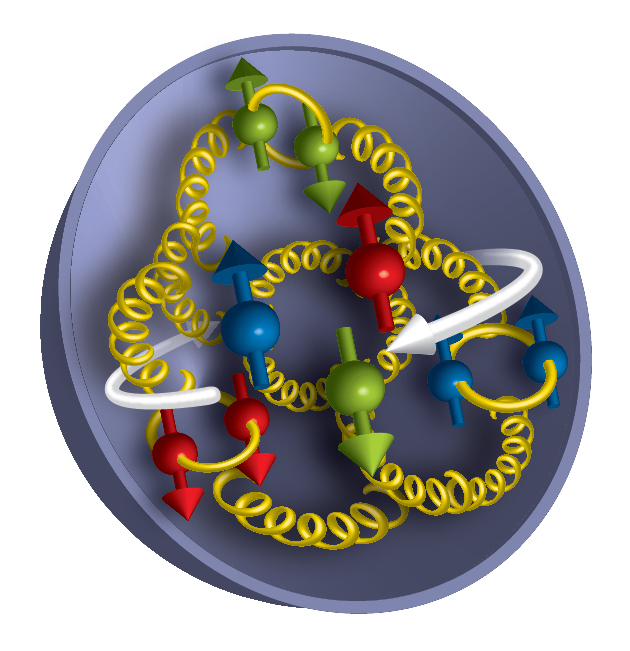reproduced from Rice News
Rice University scientists help make first measurement of antiproton attraction.
Due to the diligence of a Rice University student and his calculations, humanity now knows a little more about the universe.
Kefeng Xin, a graduate student at Rice, is one of a handful of primary authors who revealed evidence this week that the attractive force between antiprotons is similar to that between protons — and measured it.
Specifically, the team measured two important parameters: the scattering length and the effective range of interaction between two antiprotons. This gave scientists a fundamental new way to understand the force that holds together the nuclei in antimatter and how this compares to matter.
“This is about the subtle difference in the way matter and antimatter interact with each other,” said Rice physicist Frank Geurts.

Rice University physicist Frank Geurts, left, and graduate student Kefeng Xin are part of the team that made the first measurements of the attractive force between antiprotons. Xin is a primary author of the paper that appears this week in Nature. Photo by Jeff Fitlow
Antiprotons carry the opposite electrical charge and spin that protons do. Like all matter and antimatter, both were created at the instant of the Big Bang. Physicists are still trying to understand why they see so few antiparticles in nature even though particles and antiparticles were produced in equal amounts and annihilate each other on contact.
“It could have been that antimatter didn’t have the same attractive force as matter and would have helped explain how these differences, during the initial part of the Big Bang, might have resulted in antimatter not having survived in the shape of stars and planets, as matter did,” Geurts said.
“That’s where this research is helpful. The interactions between two antimatter particles turn out to be quite similar to matter particles. It may not give us a solution to the bigger problem, but we most definitely removed one option,” he said.
The find was reported in Nature on behalf of the more than 500 scientists, including Geurts, who work on the STAR experiment, part of the Relativistic Heavy Ion Collider (RHIC) at the U.S. Department of Energy’s Brookhaven National Laboratory. Brookhaven’s story on the discovery appears here.
The scattering length is a measurement of how particles deviate as they travel from source to destination; their paths are visible as three-dimensional traces captured by STAR (which is short for Solenoid Tracker at RHIC). The effective range indicates how close particles need to be for their charges to influence each other, like magnets.
Both are measured in femtometers. One femtometer is one-millionth of a nanometer; a nanometer is one-billionth of a meter.
For antiprotons measured at RHIC, the scattering length was roughly 7.41 femtometers, and the effective range was 2.14 femtometers, nearly equivalent to their proton counterparts. Measuring distances that small involves both sophisticated equipment and sophisticated calculations.
Scientists working at Brookhaven National Laboratory, including physicists at Rice, have announced the first measurements of the attractive force between antiprotons.

Scientists working at Brookhaven National Laboratory, including physicists at Rice, have announced the first measurements of the attractive force between antiprotons. The discovery gives physicists new ways to look at the forces that bind matter and antimatter. Courtesy of Brookhaven National Laboratory
“This discovery isn’t a surprise,” said Xin, whose Ph.D. thesis focuses on rather exotic systems called muonic atoms. “We’ve been studying the interaction between nucleons (particles that make up an atom’s nucleus) for decades, and we’ve always thought the forces between antimatter particles are the same as for matter. But this is the first time we’ve been able to quantify it.”
Xin, a student of Geurts, applied methods developed in his thesis to the analysis. The first task was to determine which particles produced in a collision were indeed antiprotons and whether any two were in close enough proximity to influence each other. Then came correlating their momentum from creation to destruction, typically a few nanoseconds.
“All of the data we collected in 2011 is from 500 million events (collisions between two heavy gold ions),” Xin said. “Pretty much every event can contribute.”
Antimatter can be created in small amounts with a collider like RHIC and analyzed. The collider accelerates the nuclei of heavy atoms to nearly the speed of light and smashes them together to produce elemental particles, antiparticles and exotic materials like quarks, muons and plasmas. All of these can be characterized by tools built at Rice and elsewhere as part of STAR.
RHIC smashed gold ions to produce hundreds of millions of particles, which can be detected by the ionization traces they leave in a gas-filled cylinder that surrounds the collision and a “time-of-flight” sensor. The instrument, the construction of which was led by Rice, tells researchers how many nanoseconds it takes particles to travel from the point of impact to sensors at the outer boundaries of the collider.
“RHIC is ideal for this kind of experiment because it allows us to dump a boatload of energy into a very small volume and have many particles come out of it,” Geurts said. “The multiplicity is important. If you don’t make a lot of particles, the odds of having them interact with each other is slim.”
Researchers from 52 institutions that are part of the STAR collaboration are co-authors of the Nature paper. Rice co-authors include graduate students Daniel Brandenburg, Joey Butterworth and Nick Luttrell; research scientist Geary Eppley; and Pablo Yepes, a senior faculty fellow in physics and astronomy. Geurts is an associate professor of physics and astronomy.
The research is funded primarily by the Department of Energy Office of Science.
– See more at: http://news.rice.edu/2015/11/04/antimatter-not-so-different-after-all-2/#sthash.MJ7A84cH.dpuf







